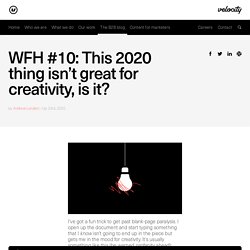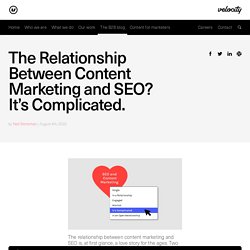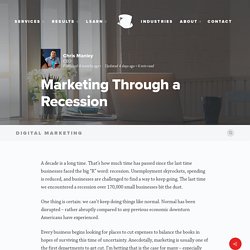

United States SEO Company. WFH #10: This 2020 thing isn’t great for creativity, is it? I’ve got a fun trick to get past blank-page paralysis.

I open up the document and start typing something that I know isn’t going to end up in the piece but gets me in the mood for creativity. It’s usually something like this (be warned, profanity ahead): “Sit down, strap in and shut the fuck up because I’m about to tell you everything you need to know about the perils of legacy IT infrastructure…”* And then I start writing. This does a few things. I know there are creatives out there who firmly believe in torturing themselves until they bleed out some copy or design or whatever but I’m not in that camp. Or at least, it usually does. Fun in the time of plague. 9 metrics all marketers should be using. It can feel like a minefield navigating the various metrics used to benchmark our progress, but understanding the trajectory of our results is a powerful method for setting up your marketing plan for success.

Essentially, it’s your goal to interpret your hard data into marketing metrics that translate into actionable insight. Why? Without thorough analysis, you’re robbing your team of the knowledge they need to make decisions on a tactical and strategic level. Without effective analysis, you’re reaching for a way forward in the dark. The only way to plan a route is via what works, and most importantly, what doesn’t. 1. Basically the total prospects you’ll have in your funnel at any one time and finding those prospects is where the work comes in. 2. Cold data lists are a thing of the past. How the Cootie Effect Can Reduce Virus Transmission. How to Structure Your Website for a Single Weekend Event. Even if your event only happens once a year, marketing is always a priority.

But how you market your event (and who you market to) should change throughout the year. One of the more nuanced parts of event marketing involves determining how your target audience changes in different seasons. And beyond that, how can you use the tools at your disposal to effectively market to those different segments? Using Your Website as a Tool If you operate a single weekend or week-long event, you should have three main marketing “seasons”: the pre-season, the event week or weekend, and the off-season.
Segmenting your marketing into different seasons allows you to focus on the different goals you have at different times of the year. And your website, the base of all your marketing activities, should be at the center of these initiatives—updating messaging, images, and content, seasonally. The Pre-Season. How to boost content marketing and SEO's relationship. The relationship between content marketing and SEO is, at first glance, a love story for the ages.

Two teams in constant thrall to one another: Search throws up big questions that need answersContent provides big answers to these questions And their union delivers sustainable, measurable results upon which every marketer dotes. But look beyond that first glance, usually and relevantly a Google search, and you’ll unearth some tricky questions that this post looks to answer (sprinkled with the odd dab of meta). Is SEO and content marketing integration so tight? Ask Google and it dutifully throws up the two peas in a pod argument. Much better at getting rankings (not a debate)More dependent on the relationship for results (open for debate) The integration on the content marketing side of the affair isn’t so clear. This, in part, comes from a limited understanding of the technical challenges of search.
The Marketing Methodology You Need to Scale Your Business Fast. This isn’t another blog post about what marketing tactics you should be using, or what metrics you should be checking weekly.

This post is about implementing a winning marketing methodology, being vigilant in seeing it through, and seeing the amazing results it will have on your ability to scale your business. You want to get in front of your target market, grab their attention, and engage with them, right? Sensory Marketing for Intangibles. 5 Tips for Marketing Through a Recession. A decade is a long time.

That’s how much time has passed since the last time businesses faced the big “R” word: recession. Unemployment skyrockets, spending is reduced, and businesses are challenged to find a way to keep going. The last time we encountered a recession over 170,000 small businesses bit the dust. One thing is certain: we can’t keep doing things like normal. Normal has been disrupted – rather abruptly compared to any previous economic downturn Americans have experienced. Every business begins looking for places to cut expenses to balance the books in hopes of surviving this time of uncertainty. The truth is: people still buy things. Consumers are still spending – perhaps just differently than they were a month ago. How do you reach those consumers? We first opened our doors here at Engenius right when the 2008 recession hit.
Here are five marketing considerations based on our own experience of not only surviving but thriving in times of uncertainty: 1. 2. 3. 4. Search Engine Optimization Course.